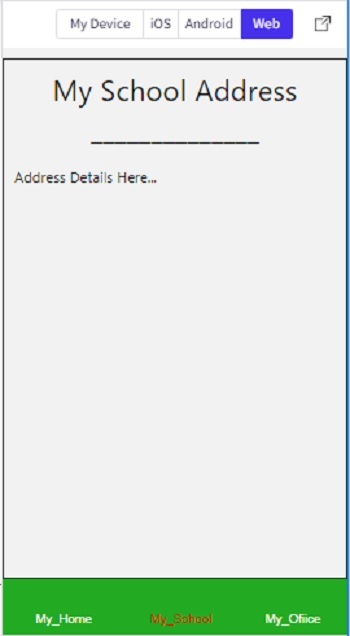在Snack中使用Material Bottom Tab Navigator
標籤用於在應用程式中實現多頁面檢視。標籤通常放置在螢幕頂部或底部。一些庫允許在移動應用程式中建立標籤。標籤可以使用圖示代替文字型別的標籤。在本文中,展示了 React Native 和 Javascript 程式碼,其中包含兩個不同的示例,第一個示例使用來自 '@react-navigation/material-bottom-tabs' 的 createMaterialBottomTabNavigator 來建立標籤,然後將它們呈現為標籤。在另一個示例中,使用來自 Ionicons 的圖示來建立標籤,然後將它們渲染到裝置螢幕上。
演算法 1
步驟 1 - 從 'react-native' 中匯入 Text、View、StyleSheet。
步驟 2 - 從 '@react-navigation/native' 中匯入 NavigationContainer,然後從 '@react-navigation/material-bottom-tabs' 中匯入 createMaterialBottomTabNavigator。
步驟 3 - 編寫單獨的箭頭函式來顯示不同頁面的內容。
步驟 4 - 建立 App.js 並編寫程式碼。使用 createMaterialBottomTabNavigator() 建立 BtmTbs。
步驟 5 - 建立 NavigationContainer 標籤並在其中建立 BtmTbs.Navigator。從不同的 BtmTbs.Screen 呼叫頁面內容函式。
步驟 6 - 檢查結果。
示例 1:使用來自 '@react-navigation/material-bottom-tabs' 建立標籤型別標籤。
在此示例中,使用 createMaterialBottomTabNavigator 和 ‘@reactnavigation/material-bottom-tabs’ 來開發標籤型別標籤。
專案中使用的重要檔案是
App.js
App.js:這是此專案的 javascript 主檔案。
import{Component}from'react';
import{Text,View,StyleSheet}from'react-native';
import{NavigationContainer}from'@react-navigation/native';
import{createMaterialBottomTabNavigator}from'@react-navigation/material-bottom-tabs';
constBtmTbs=createMaterialBottomTabNavigator();
exportdefaultclassBottomBtmTbsExampleOneextendsComponent{
render(){
return(
<NavigationContainer>
<BtmTbs.Navigator
initialRouteName="My_Home"
activeColor="#c00"
inactiveColor="#ffe"
barStyle={{backgroundColor:'#2a2'}}>
<BtmTbs.Screenname="My_Home"component={AddressHome}/>
<BtmTbs.Screenname="My_School"component={AddressSchool}/>
<BtmTbs.Screenname="My_Ofiice"component={AddressOffice}/>
</BtmTbs.Navigator>
</NavigationContainer>
);
}
}
AddressHome=()=>(
<Viewstyle={styles.Addresscontents}>
<Textstyle={styles.AddressHeader}>MyHomeAddress</Text>
<Textstyle={styles.AddressHeader}>______________</Text>
<br/>
<Textstyle={styles.AddressContent}>AddressDetailsHere...</Text>
</View>
);
AddressSchool=()=>(
<Viewstyle={styles.Addresscontents}>
<Textstyle={styles.AddressHeader}>MySchoolAddress</Text>
<Textstyle={styles.AddressHeader}>______________</Text>
<br/>
<Textstyle={styles.AddressContent}>AddressDetailsHere...</Text>
</View>
);
AddressOffice=()=>(
<Viewstyle={styles.Addresscontents}>
<Textstyle={styles.AddressHeader}>MyOfficeAddress</Text>
<Textstyle={styles.AddressHeader}>______________</Text>
<br/>
<Textstyle={styles.AddressContent}>AddressDetailsHere...</Text>
</View>
);
conststyles=StyleSheet.create({
Addresscontents:{
flex:1,
width:'100%',
padding:10,
marginTop:10,
borderWidth:1,
borderColor:'black',
},
AddressHeader:{
color:'black',
fontSize:28,
textAlign:'center',
},
});
輸出
可以線上檢視結果。當用戶輸入程式碼時,Web 檢視會預設被選中,結果會立即顯示。

演算法 2
步驟 1 - 從 'react-native' 中匯入 Text、View、StyleSheet。從 'react-native-vector-icons/Ionicons' 中匯入 Icon。還從 'react-navigation' 中匯入 createAppContainer。
步驟 2 - 編寫單獨的函式來顯示不同頁面的內容。
步驟 3 - 建立 App.js 並編寫程式碼。建立名為 My_Home、My_School 和 My_Office 的類來建立螢幕。
步驟 4 - 使用 createMaterialBottomTabNavigator() 建立 BtmTbs。現在使用 tabBarIcon 選擇圖示並設定圖示屬性。
步驟 5 - 使用 createAppContainer 並使用 BtmTbs 作為引數。從不同的 BtmTbs.Screen 呼叫頁面內容函式。
步驟 6 - 檢查結果。
示例 2:在 Snack 上使用來自 Ionicons 的圖示建立標籤。
專案中使用的重要檔案是
App.js
App.js:這是此專案的 javascript 主檔案。
示例
import {Component} from 'react';
import {StyleSheet, Text, View} from 'react-native';
import {createAppContainer} from 'react-navigation';
import { createMaterialBottomTabNavigator } from 'react-navigation-material-bottom-tabs';
import Icon from 'react-native-vector-icons/Ionicons';
class My_Home extends Component {
render() {
return (
<View style={styles.Addresscontents}>
<Text style={styles.AddressHeader}>My Home Address</Text>
<Text style={styles.AddressHeader}>______________</Text>
<br/>
<Text style={styles.AddressContent}>Home Address Details Here...</Text>
</View>
);
}
}
class My_School extends Component {
render() {
return (
<View style={styles.Addresscontents}>
<Text style={styles.AddressHeader}>My School Address</Text>
<Text style={styles.AddressHeader}>______________</Text>
<br/>
<Text style={styles.AddressContent}>School Address Details Here...</Text>
</View>
);
}
}
class My_Office extends Component {
render() {
return (
<View style={styles.Addresscontents}>
<Text style={styles.AddressHeader}>My Office Address</Text>
<Text style={styles.AddressHeader}>______________</Text>
<br/>
<Text style={styles.AddressContent}>Office Address Details Here...</Text>
</View>
);
}
}
const BtmTbs = createMaterialBottomTabNavigator(
{
My_Home: {
screen: My_Home,
navigationOptions:{
tabBarLabel:'My_Home',
tabBarIcon: () => (
<View>
<Icon size={25} name={'ios-home'}/>
</View>),
}
},
My_School: {
screen: My_School,
navigationOptions:{
tabBarLabel:'My_School',
tabBarIcon: () => (
<View>
<Iconsize={25} name={'school'}/>
</View>),
activeColor:"#c00",
inactiveColor:"#ffe",
barStyle: { backgroundColor: '#2a2' },
}
},
My_Office: {
screen: My_Office,
navigationOptions:{
tabBarLabel:'My_Office',
tabBarIcon: () => (
<View>
<Iconsize={25} name={'headset'}/>
</View>),
activeColor:"#c00",
inactiveColor:"#ffe",
barStyle: { backgroundColor: '#2a2' },
}
},
},
{
initialRouteName: "My_Home",
activeColor:"#c00",
inactiveColor:"#ffe",
barStyle: { backgroundColor: '#2a2' },
},
);
const styles = StyleSheet.create({
Addresscontents: {
flex: 1,
width: '100%',
padding: 10,
marginTop: 10,
borderWidth: 1,
borderColor: 'black',
},
AddressHeader: {
color: 'black',
fontSize: 28,
textAlign: 'center',
},
});
export default createAppContainer(BtmTbs);
輸出
可以線上檢視結果。當用戶輸入程式碼時,Web 檢視會預設被選中,結果會立即顯示。

在本文中,使用兩個不同的示例,給出了在 Expo Snack 上使用 Material Bottom Tab Navigator 顯示不同形式的底部標籤的方法。首先,給出了建立標籤型別底部標籤的方法。第二個示例介紹了建立圖示型別底部標籤的方法,並在線上 Web 檢視中顯示了輸出。


 資料結構
資料結構 網路
網路 關係型資料庫管理系統
關係型資料庫管理系統 作業系統
作業系統 Java
Java iOS
iOS HTML
HTML CSS
CSS Android
Android Python
Python C語言程式設計
C語言程式設計 C++
C++ C#
C# MongoDB
MongoDB MySQL
MySQL Javascript
Javascript PHP
PHP